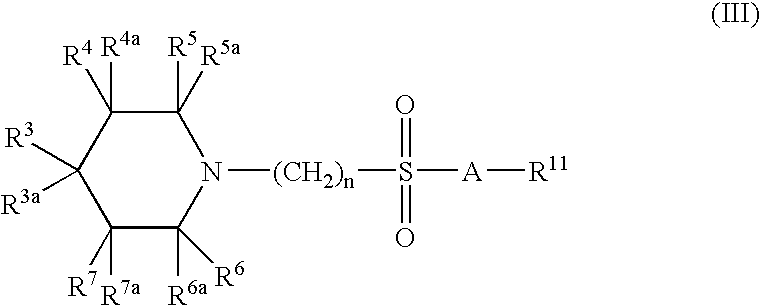Methods and compositions for treating amyloid-related diseases
a technology for amyloid-related diseases and compositions, applied in drug compositions, biocides, metabolic disorders, etc., can solve the problems of amyloid fibrils, once deposited, becoming toxic to surrounding cells, progressive memory loss, severe pain, etc., to slow down deposition, and block amyloid-induced neurotoxicity or microglial activation
- Summary
- Abstract
- Description
- Claims
- Application Information
AI Technical Summary
Benefits of technology
Problems solved by technology
Method used
Image
Examples
example 11
Evaluation of Compounds Binding to NAC Peptide by Mass Spectrometry
[0447]Recent findings have demonstrated that a high percentage of Alzheimer Disease (AD) patients also form Lewy bodies, most abundantly in the amygdala (Hamilton. 2000. Brain Pathol, 10:378; Mukaetova-Ladinska, et al. 2000. J Neuropathol Exp Neurol 59:408). Interestingly, the highly hydrophobic non-amyloid component (NAC) region of α-synuclein has also been described as the second most abundant component of amyloid plaques in the brain of AD patients, after Aβ. Alpha-synuclein has been shown to form fibrils in vitro. Futhermore it binds to Aβ and promotes its aggregation (Yoshimoto, et al. 1995. Proc Natl Acad Sci USA 92:9141). It was in fact originally identified as the precursor of the non-amyloid beta (Aβ) component (NAD) of AD plaques (Ueda, et al. 1993. Proc Natl Acad Sci USA 90:11282; Iwai. 2000. Biochem Biophys Acta 1502:95; Masliah, et al. 1996. Am J Pathol 148:201). NAC is a 35 amino acid long peptide with ...
PUM
| Property | Measurement | Unit |
|---|---|---|
| concentration | aaaaa | aaaaa |
| pH | aaaaa | aaaaa |
| particle size | aaaaa | aaaaa |
Abstract
Description
Claims
Application Information
 Login to View More
Login to View More - R&D
- Intellectual Property
- Life Sciences
- Materials
- Tech Scout
- Unparalleled Data Quality
- Higher Quality Content
- 60% Fewer Hallucinations
Browse by: Latest US Patents, China's latest patents, Technical Efficacy Thesaurus, Application Domain, Technology Topic, Popular Technical Reports.
© 2025 PatSnap. All rights reserved.Legal|Privacy policy|Modern Slavery Act Transparency Statement|Sitemap|About US| Contact US: help@patsnap.com



